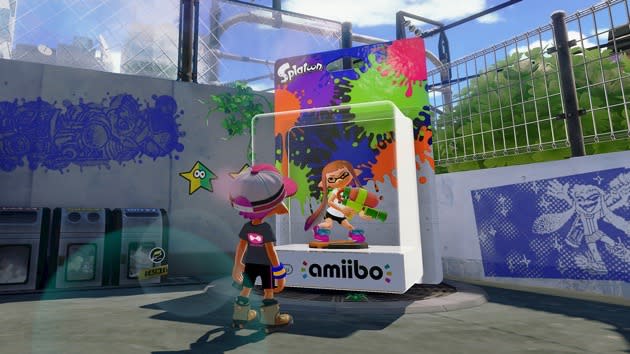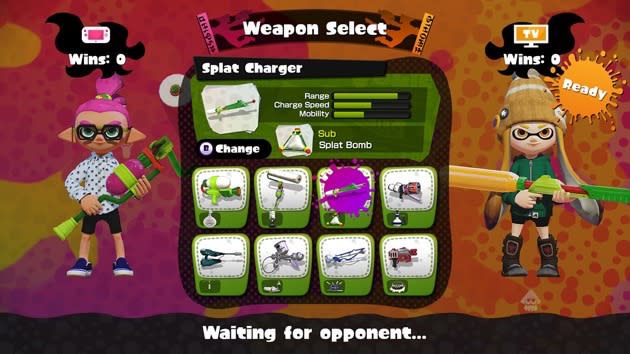The magic of Nintendo's new shooter 'Splatoon' is in its multiplayer

My Nintendo 64 memories have nothing to do with GoldenEye 007, the famed first-person James Bond shooter that helped define the genre. Unlike seemingly every other N64 owner, I never played that game because, quite frankly, shooters aren't my thing. With Splatoon, Nintendo's quirky, new third-person action shooter for the Wii U, ready for release on May 29th, however, it may be time I change my tune.
There are two critical things Splatoon accomplishes for Nintendo: It breathes life into the Wii U's Zelda-less 2015 lineup and it's a completely new IP, which should please loyalists. The game boasts Nintendo's signature polish as it's filled to the brim with colorful art direction, instantly lovable characters (i.e., the Inklings) and a whimsical squid-ink twist on the shooter genre. What's more, it's meant to be "primarily a four vs. four online turf war battle," according to Corey Olcsvary of Nintendo's Treehouse. That's right, with Splatoon, Nintendo's putting online multiplayer first; that's an actual first for the company, which typically favors local multiplayer a la Super Smash Bros. The demo I played, however, was focused on the single-player campaign and corresponding Amiibo challenges, so the verdict's still out on how the multiplayer "meat and potatoes" of the game'll pan out.
Shigeru Miyamoto, Nintendo's celebrated Mario maker and overseer of the company's prestigious EAD studio (from which Splatoon hails), is famously averse to a story-first approach to game design, opting instead to focus on "fun" gameplay. And so, Splatoon follows that blueprint with a thin conceit: You, a member of the Inklings, are trying to regain ownership of the Great Zap Fish from archrivals, the Octarians. That's it. That's the story.

Players that enter the world of Splatoon begin and end their journeys in a hub world known as Inkopolis. It's from here that you'll enter a tower to begin multiplayer tournaments; enter a sewer for single-player campaign; approach an Amiibo box to play those additional campaign challenges; or shop for upgrades like shoes, hats and outfits. There's no extended ability to converse with the other players that inhabit your hub world as Inkopolis functions much like Wara Wara Plaza on the Wii U home screen. Only player stats will be accessible through interaction with others in the hub.
The single-player campaign in Splatoon plays out more like an extended training exercise and, according to Olcsvary, that's entirely by design. It's intended to help ramp up players' skill levels so they'll be able to confidently enter and compete in online matches. Each level in the campaign introduces a new mechanic or play style to gradually build up a player's arsenal of moves and also get them acquainted with the various battle environments.
In typical Nintendo style, this is done so effortlessly as to be invisible. The first levels of Splatoon's campaign, while not childishly simple, don't quite present much of a challenge. The enemies remain mostly static and the platforming elements are non-threatening. Most of that initial play time is spent coming to grips with the somewhat on-rails world of Splatoon and the motion controls of the GamePad, which are used to manipulate the camera. That said, players looking for a more traditional shooter setup can remap the camera to the right analog stick. Although, in practice, I much preferred the default motion setting.

The controls in Splatoon are otherwise fairly straightforward: To spray ink, you simply depress ZR (sorry, but there's no targeted lock-on). To swim in your inkblots as a squid, you depress ZL. Ink capacity can be re-upped by swimming around and the ability to swap out weapons, of which there are three types (rapid-fire, charger and roller), comes only in multiplayer or Amiibo challenge modes. Upgrades in single-player are limited. Unlike the coins granted by online matches, campaign mode requires players to collect power eggs to improve stats (e.g., faster ink tank refills), not gear. So you'll be stuck with the "hero suit" for the duration of the single-player campaign.
If you happen to conquer all 20 challenges offered by an Amiibo figurine, however, your Inkling will be rewarded with a special outfit: a schoolgirl look for the female Inkling, a samurai look for the boy Inkling and a "ridiculous" outfit for the squid. The major caveat here being that you must first unlock all the single-player levels in order to even access the additional Amiibo challenges.
As much as I was excited for the single-player experience in Splatoon, it lacks the compelling magic the IP was built around -- and that's the multiplayer mayhem. Though I enjoyed progressing from objective to objective, ink-blasting baddies and leveling up my proficiency in the increasingly difficult campaign, it wasn't until I went head to head with another local player in Battle Dojo (versus mode) that I began to see the game's frantic appeal. And this is where the Wii U's unique design comes into play, as one player uses the GamePad as both controller and screen, while the other gets the TV and a separate controller (likely a Pro).

I'll admit, I got my ass handed to me several times over while battling in local multiplayer -- I'm crap at shooters -- but I never felt discouraged and the gameplay never felt unfair. In fact, there are plenty of player assists in the form of power-up crates sprinkled throughout the sandboxed levels. The objective of this mode is simple: Pop as many balloons as you can and impede your opponent's progress (read: Literally slow them down) by spraying the terrain with your color ink. It sounds simple, but it's wonderfully maddening to play.
As enjoyable as Splatoon is in its more limited modes, I still couldn't shake the sense that I was missing the larger picture. It appears as though much of the game's mass appeal will live and die by the success of its online multiplayer aspect. And for that, we'll have to wait and see.
[Image credits: Nintendo]

